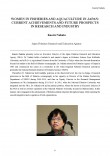Women in fisheries and aquaculture in Japan: Current achievements and future prospects in research and industry

To “Ensure women’s full and effective participation and equal opportunities for leadership at all levels of decision-making in political, economic and public life” was adopted as one of the targets of Sustainable Development Goal (SDG) 5, as a component of the aim to “Achieve gender equality and empower all women and girls” as stated on the United Nation’s Sustainable Development Knowledge Platform. In the fisheries sector in Japan, female workers constitute 13% of those engaged in fishing activities (fishers), 38.4% of land-based workers, and 64% of those involved in the marine products- processing industries. However, the percentage of women at the decision-making levels in these various endeavors are extremely low. The rates of ordinary members and those serving in official capacities in fisheries cooperative associations are as low as 5-6% and 0.5%, respectively. Similar trends are also found in the fields of education and research. For example, the percentage of women researchers holding formal positions in the Japan Fisheries Research and Education Agency (FRA) has reached 11%, but those engaged in management-level positions constitute only 3% of the total.
In 2015, numerical targets for ratios of women at the management/decision-making level of incorporated administrative agencies in Japan, such as the FRA, were established under the Fourth Gender Equality Basic Plan. The FRA has been exerting efforts to increase recruitment levels of female researchers into the organization, and to furthermore promote capable women to the management/decision-making level (Fig. 1). At the present time, there is a very small candidate pool for women researchers who are at the career stage eligible for such promotion; hence, it will take time to reach the desired numerical targets, but this goal is starting to be realized.
In Japan, fishery-related production has declined in recent years, and the fisheries industry is facing an aging crisis. An increase of women members at the decision-making level in local communities is expected to lead to the establishment of various systems that will consider women’s needs and utilize their talents. Women are regarded to have a high level of competence in communicative skills, and in this regard, it is highly probable that their active participation will bring new power and energy to their respective communities. Increasing women’s participation in both the local community and in the research arena will be key to achieving a much-needed boost to Japan’s fisheries sector.
| 別タイトル | 日本国内における水産業への女性たちの貢献および今後の活躍について |
|---|---|
| 刊行年月日 | |
| 作成者 | Kaoru Nakata |
| 著者キーワード | Decision-making levels Fourth Gender Equality Basic Plan Sustainable Development Goal (SDG) 5 |
| 公開者 | Japan International Research Center for Agricultural Sciences |
| オンライン掲載日 | |
| 国立情報学研究所メタデータ主題語彙集(資源タイプ) | Conference Paper |
| 号 | 2018 |
| 開始ページ | 17 |
| 終了ページ | 22 |
